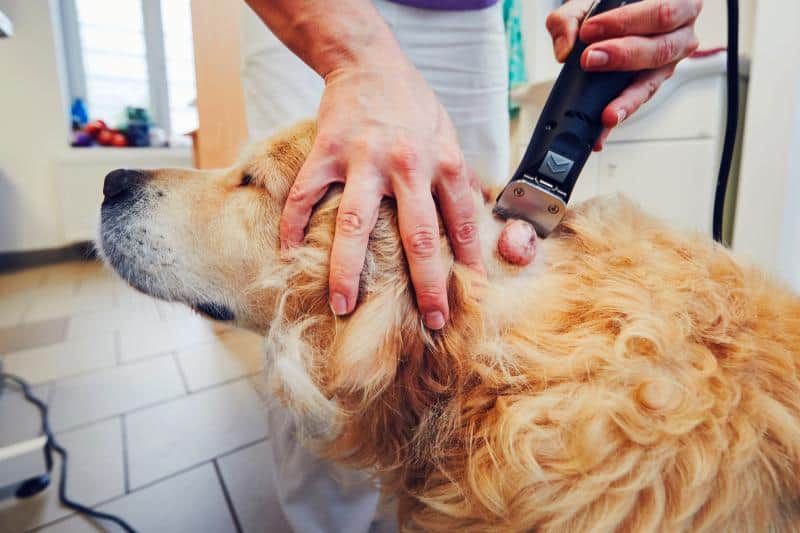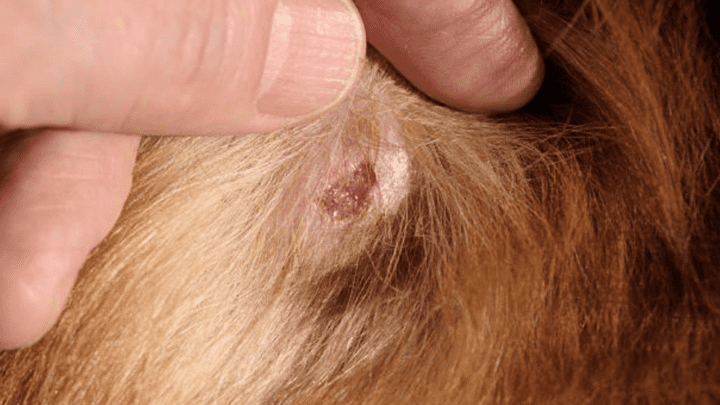- How to Figure Out Your Dog’s Age - January 8, 2022
- Prescription Diet Dog Food Guide and Recommendations - December 12, 2019
- How To Take Care of Your Bichon Frise (Grooming Tips) - December 12, 2019
If you are a dog parent like me, then you know that checking your dog’s skin is vital to his/her health. Just like humans, dogs tend to develop small circular bumps on their skin called sebaceous cysts. Most skin cysts are scary to look at but are not dangerous to your pet which is why most insurance companies will not cover them.
However, as your dog reaches old age, skin cysts can turn into cancerous tumors. So, it is important for your veterinarian to examine the growth to determine whether it needs to be removed. Most insurance companies will cover the surgical procedure if your vet deems it necessary. The extraction is very expensive so I highly recommend pet insurance coverage because the biopsy results will determine whether additional medical treatment is necessary.
What Is a Skin Cyst, What Are the Symptoms, and Why Is It Important?

Dogs’ shiny and healthy coats are due in part to sebaceous glands which produce sebum, an oily substance that lubricates both their skin and coat.
When the sebaceous gland becomes clogged from an obstructed pore or follicle, it causes the skin to swell thus creating a rubbery- like bump on your dog’s skin. This benign white tumor is called a sebaceous cyst (also referred to as epidermoid or an epidermal inclusion cyst).
While most cysts are not dangerous or uncomfortable to your dog because they can’t feel it, sometimes the cyst will rupture leaving the wound open and vulnerable to infection.
Most of the time, all you have to do is clean the area and disinfect it several times a day. Your vet will give you an ointment or recommend something over the counter which should clear the area up after a few days.
How Are Skin Cysts Treated and What Happens During Treatment?
The best thing to do with a skin cyst is to leave it alone. Be careful when you brush your dog’s coat and remain vigilant in checking his/her skin. Never squeeze the cyst because you will hurt your pooch by triggering a bacterial infection requiring your dog to take antibiotics.
The problem with a cyst starts when it starts to affect your dog’s quality of life. For example, if a cyst grows inside the paw, it may become aggravated as it touches the ground and thus makes it painful for your dog to walk.
Cysts burrowed under the skin sometimes burst and cause your dog to lick, scratch and/or rub the thick milky excretion. Pay attention to your dog if he/she starts to do so because your furry one will cause it to get infected.
If the cyst bursts and a yellowish/brown matter oozes out, you will know it is infected by its accompanying foul odor, pus or both. Your vet will prescribe your dog antibiotics and anti-inflammatory medications.
If a skin cyst grows abnormally fast, becomes discolored (dark, red), or is severely infected your vet will most likely recommend it be surgically removed and sent out to be biopsied to determine whether or not the cyst is an adenocarcinoma (malignant/cancerous tumor).
How Much Does Skin Cyst Treatment Cost?
Treatment for skin cysts are extremely expensive and range from $75 to $1500 depending on how many cysts must be removed, the location of the cyst and how difficult the procedure will be. Keep in mind, the cyst is priced separately from all the other pre and post-surgical tests your dog will need.
Plan Coverage Comparison for Skin Cysts

The costs of insurance company plans vary depending on which plan you chose. What seems to be a common factor, however, is that all insurance companies pay on a reimbursement basis. You will need to pay upfront, submit a claim, and wait for the insurance company to evaluate the medical treatment before they send you a check.
Also, none of these insurance companies cover pre-existing conditions (any condition that started prior to your insurance coverage).
Because all pet insurance companies require the age and breed of your dog, you must research each company to find out which one offers the best plan for your furry loved one.
Healthypaws has been rated by far as the most popular and effective pet insurance. You can enroll your dog until age 14 and he/she will be covered for life. There are no limitations on how many times your dog is diagnosed with the same condition and no restrictions on conditions brought on by old age or that were inherited. And, they cover skin cysts.
Yes, You Should Have Pet Insurance for Skin Cysts
The bottom line is yes. If you can afford it, pet insurance will save you money along the way. Unfortunately, sooner or later your best friend will end up with a cyst because it’s a normal part of a canine’s cycle in life.
And while there is no guarantee that your dog will never get cancer, as your companion reaches his/her golden years, he/she will be more prone to skin infections.
Take it from someone who knows. Last year, my thirteen-year-old Bichon Frise had two darkish huge cysts on her abdomen so her vet had them extracted and biopsied for cancer. Not only was I relieved when I found they cysts were benign but glad I had my insurance to help me cover some of the cost. Phew!
Continue reading:
Does Pet Insurance Cover Vaccinations? (Costs)




